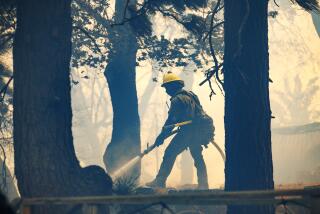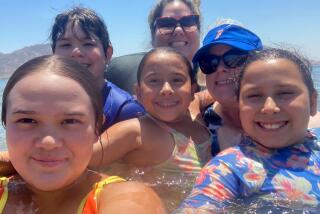Granite Mountain hotshots escorted home in solemn procession
PHOENIX, Ariz. -- Earlier that day, Margaret Reed wondered how she should react. Should she clap as the hearses carrying the 19 firefighters rolled past? Salute? Or stand solemnly and quietly on the sidewalk, filled with thoughts and prayers for their families?
Reed and her husband sweated in 100-degree heat with others in downtown Phoenix as they awaited the procession for the Granite Mountain hotshot firefighters. It was to begin at the Maricopa County medical examiner’s office, pass through the small mountain highways and towns that the men died protecting, and stop where many had grown up, in Prescott, Ariz.
Reed took ice cubes from her red cooler. She and other women melted the ice on their chests and inside their bras. The procession was almost an hour late.
“I hope nothing happened” at the medical examiner’s office, she told her husband. But she would wait all day if need be.
An hour earlier and blocks away, in front of the beige building where the bodies had been kept, firefighters and police officers tugged their white gloves tight and marched in place with shined black shoes, somber faces and raised flags, uniforms and proceedings typically reserved for celebration or mourning.
Five firemen in kilts rehearsed with their bagpipes but still had not decided whether to play “Amazing Grace,” “Going Home” or the eerie retreat march called “Balmoral.”
Chris Broadley had left his kilt at home.
“You can borrow mine,” one of them jested.
Broadley grinned and shook his head. He hadn’t had time to grab it that morning because he had rushed from the Chandler fire station, where last week he sat at a table with eight other firefighters eating dinner. He had pulled out his phone that night and casually skimmed the news.
He was the first in the station to learn that 19 Granite Mountain hotshots were missing and possibly dead. They all waited in front of the TV to see whether it was true.
The crowd had begun to gather on Washington Street, a four-lane road running to the Arizona State Capitol. Spectators lined the street with flags in hand. Firetrucks from across the state parked along the route. Children accepted plastic hats and stickers from firefighters, who had already hung an enormous American flag from two ladder trucks.
As the first black SUV appeared, the men in kilts played a fanfare on a drum. Then, with bagpipes, they played “Balmoral,” which started with a sound like rushing wind.
The remains of Eric Marsh, the hotshot team’s leader, passed first in a white hearse. Then 31-year-old Travis Carter, thought to be the toughest and most humble in the crew, followed by Clayton Whitted, known for his big smile; then Robert Caldwell, said to be crew’s smartest.
Fifteen more white hearses with the Granite Mountain Interagency Hotshot Crew logo passed by.
More than 25 Phoenix police officers on motorcycles led the hearses. As the sound of whirling engines approached, Reed waited with her husband near the giant flag hanging from the firetruck ladders. She edged near the blacktop, waiting to see how the crowd would react.
The procession passed a man who had lived in Arizona for only a year, but who endured the heat to watch. It passed a group of Vietnam War veterans who perform services at soldiers’ funerals.
As the procession neared Reed, she felt a silence.
But as the hearses arrived, everyone cheered. The crowd smiled and cried at the same time.
It felt odd to clap on behalf of men who would never hear, she thought. But it wasn’t clapping and cheering as at a parade; it felt more reverent, like a farewell.
The solemn procession headed toward Prescott. Toward home.
ALSO:
Wisconsin governor signs bill restricting abortion
Sept. 11 firefighter’s remains are finally identified
In Arizona fire’s aftermath, Prescott is ‘turning into a memorial’
More to Read
Sign up for Essential California
The most important California stories and recommendations in your inbox every morning.
You may occasionally receive promotional content from the Los Angeles Times.










